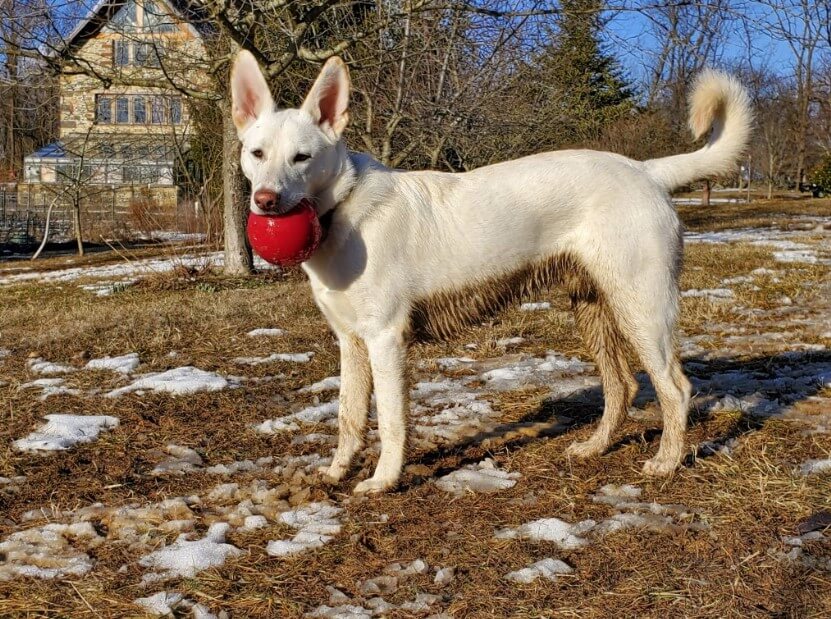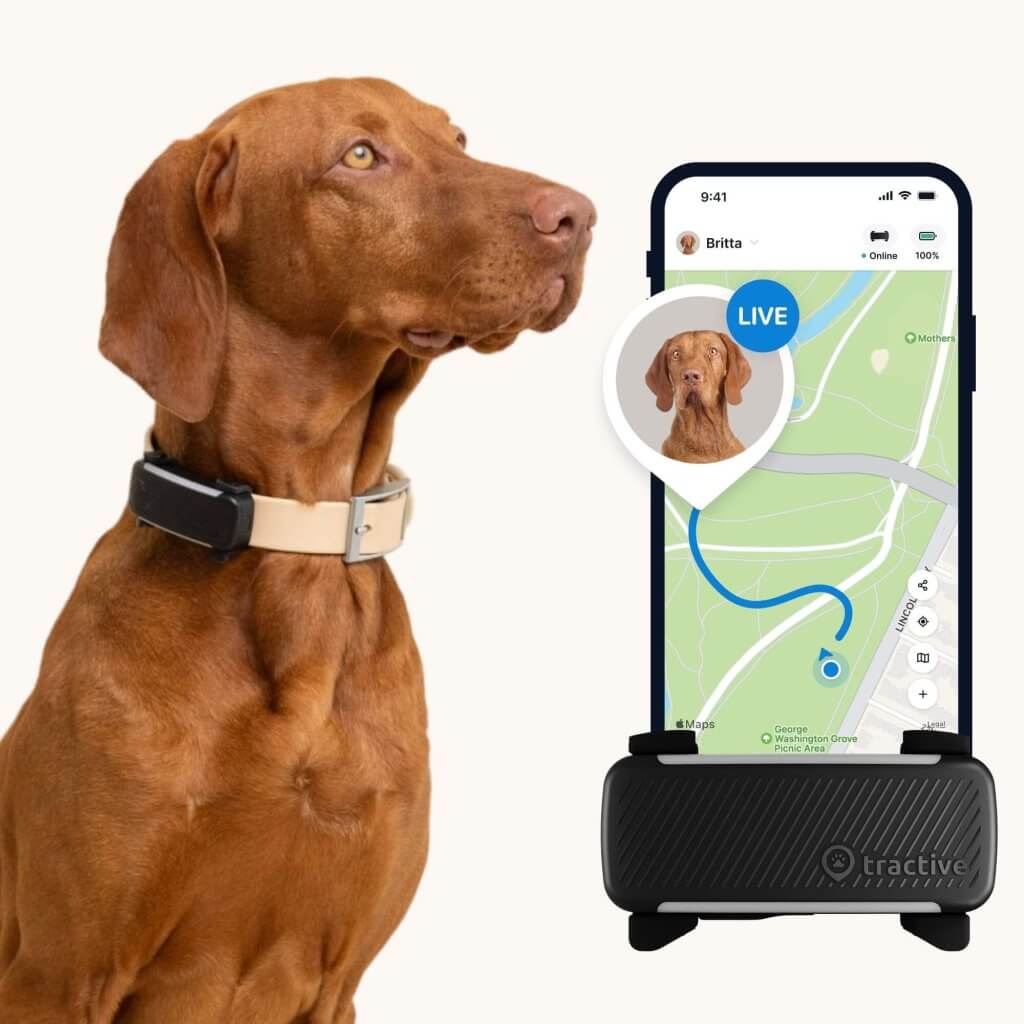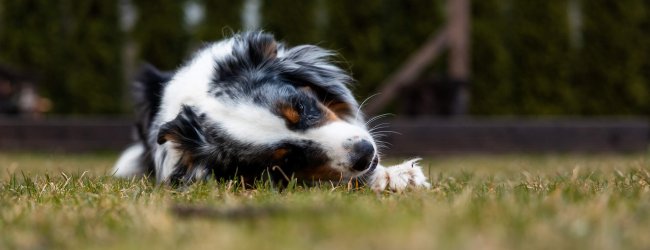 Approved by Dr. Dwight Alleyne, DVM
Approved by Dr. Dwight Alleyne, DVM How Often Should You Walk Your Dog?
Regular walks aren't just great for us - it's also one of the best ways to keep your dog healthy & happy. Here's how often to go out on them, based on your dog's age, health, and breed - plus your lifestyle.

Whether you’re a new dog parent or a veteran, it’s completely normal and healthy to be wondering – how often should you walk your dog? Here’s a deep dive into how frequently – and how long – you should walk your dog each day, based on factors like breed and age. And even better, how to keep them safe if they bolt the leash while you’re out together.

Always know your buddy is healthy & safe
Read moreHow often should I walk my dog?
On average, vets recommend walking the dog 3 – 4 times per day for at least 15 minutes.2 However there are a couple of factors that come to play when deciding how often you walk your dog.
No matter their age, breed, or size – every dog needs regular physical activity.1 Walking your dog daily helps keep them healthy – both physically and mentally. Regular dog walks can even help reduce any behavioral problems you experience with your buddy. But how often you should walk them depends on things like their:
Breed
Every dog belongs to a particular breed, each of which has specific activity needs and limitations. For example, for some small dogs, one walk a day might be enough. This generally isn’t the case however for high-energy dog breeds.
High-energy dog breeds
- Border Collie
- Australian Shepherd
- Dalmatian
- Irish Setter
- Rhodesian Ridgeback
- Weimaraner
- Labrador Retriever
- Siberian Husky
Outdoor adventures are the perfect way to bond with these breeds. Whether you go for a walk, hike or run, your canine buddy will make the trip twice as fun. Aim for 30 minutes to 2 hours of exercise each day – or 2 to 3 daily walks.

💡Pictured here is Opie, a high-energy Shepherd mix whose Tractive device clocks in a whopping 300-500 minutes of activity per day!
“We thought we were crazy for a while,” says his mom, Autumn. “Then, we discovered Tractive and were relieved to find out we weren’t crazy – Opie really was the most active dog around.”
Low energy dog breeds
On the other hand, some dogs are low energy breeds and need less exercise daily. These include:
- Bassett Hounds
- Pekingese
- Yorkshire Terriers
- Bulldogs
- Mastiffs
- Great Danes
- Newfoundlands
Sheep & cattle dogs
These dog groups have a higher need for activity:
- Sheepdogs, such as Sheltie Sheepland or Border Collie
- Cattle dogs, such as Bouvier des Flandres
Dogs belonging to this group need a minimum of 2.5 hours of intense activity per day. Translated into walks, this can easily mean at least 4 walks a day, 20-25 minutes each. Since dogs belonging to this category are also very intelligent, don’t forget to challenge them mentally as well. Reserve at least 30 minutes every day for intelligence game sessions with them.
Terriers
This dog group may be small, but these four-legged friends also need a quite large amount of exercise. Terriers need at least 1.5 hours of activity every day. Consider a friendly walking schedule of 3 walks per day, 20-25 min each.

Hunting dogs
Breeds belonging to this group definitely need an activity challenge. Here are a couple of examples:
- Dalmatians
- Greyhound
- Beagles
- Pinschers
- Schnauzers
- Greyhounds
- Whippets
- Setters
For dogs bred for hunting, 1.5 hours of daily walks and exercising is the minimum requirement. Since these dog breeds are also pretty fond of running, feel free to start a running practice with them, as long as you do it step-by-step and considering the age of your dog as well. Try and aim for 3 walks a day of at least 30 minutes, plus training and play.
Companion dogs
Chihuahua and similar breeds are typically what we nowadays call companion dogs. As these dogs are not high-energy breeds, avoid challenging them with hours of intense activity. Instead, use smaller time periods for fun games and short daily walks to keep them physically fit. Small companion dogs may only need about 30 minutes of exercise per day.
Age
Puppies, for example, might seem to have an endless amount of energy. But even they aren’t able to walk as long as older dogs. They may also need more frequent potty breaks. So stick with short but frequent walks for puppies.
Younger dogs (under 5 years old) typically have a lot of energy, so they often need more exercise than adult and senior dogs.
Middle-aged and senior dogs may have health issues that slow them down. They might be eager to walk a lot, but not have the stamina to keep up. Keep all this in mind when considering how often to walk your dog.
Lifestyle
Other factors in your living situation and lifestyle affect how often you should walk your dog. Like, for example:
- How active you are
Dogs tend to mimic the activity and routine of their caregivers. (Aka, us.) So if you’re generally sporty and your dog tags along for your runs, swims, and hikes, they won’t need as many walks. On the other hand, if you’re more inactive, chances are your dog will be too. So it’s very important to walk daily. - Living space. If you and your dog live in a small apartment with not much space to move around, you’ll need to walk them more often. On the other hand, if you’ve got a big backyard with space to roam, your dog needs fewer walks. (Just watch out for an active dog who might jump the fence.)
Your environment
Ever felt lazy to go out on a walk seeing the miserable weather outdoors? You wouldn’t be the only one. But turns out, the weather – and your environment as a whole – does affect how often you should venture outdoors with your dog.
- Hot weather
When it gets warmer outdoors, it’s a good idea to avoid walking around mid-day – or when the sun’s at it’s peak. Steer clear of areas without shade and try and walk around evening time, when it’s cooler. (Or there’s a bit of a breeze or cloud cover.) - Cold weather
Most dogs can safely withstand temperatures above 45°F (7°C) – anything below, and you’ll see them get uncomfortable. Make sure to dress warmly and protect your dog’s paws from ice, salt, and snow. (Yes, even if you’ve got a snow-loving dog breed.) Also, given how it gets darker earlier in autumn and winter, invest in reflective gear to help your dog stay visible.
Health
Last but not least, you should consider your dog’s health when deciding how often to walk your dog. Dogs in great health may be able to enjoy long walks – up to two hours or more. On the other hand, dogs with health problems like obesity or diabetes will likely have challenges walking.
Some brachycephalic (or flat-nosed) dog breeds, like pugs, Bulldogs, and Boxers might be reluctant exercisers. The shape of their heads makes it difficult for them to breathe – so they’re vulnerable to health problems like sleep apnea. Make sure to get the green light from your vet before beginning your daily dog walks.
Tips for walking your dog safely outdoors
Before you head outdoors, here are a couple of safety tips for a stress-free walk together with your buddy.
- Dog ID tag
Make sure your dog’s collar includes an ID tag with your contact details. (In case they run away.) - Microchip
A microchip works like a permanent ID tag for your dog. (So more secure than a dangling ID tag that might fall off.) Now if they run away and are picked up by a vet or animal shelter, your dog’s microchip helps them identify you as the rightful owner. - Weather
Stay informed on how to handle hot weather when you’re out on a walk with your dog – and also how cold is too cold for dogs. - Gear
Always bring water if you’re going for a longer walk. Also consider dog booties, a jacket, or reflective gear if necessary – especially if you’re walking your dog in the dark. - Leash and harness
Most places around the world have laws that require you to walk your dog on a leash. Make sure to check your local laws or wherever you’re visiting and ensure a specific spot is a designated off-leash zone before letting your buddy run around unleashed. - GPS tracker
If your active dog has a tendency to run off – especially on walks – it can only take minutes for it to escalate to an emergency. But if they’ve got a GPS tracker strapped to their collar, you can figure out where they’ve run off to with just a glance at your phone. Follow your dog’s movements in real-time and never fear losing them while out on a walk again.

Follow your dog anywhere
Get real-time location information, wherever they go. And find out when they try to make an escape, or just when they go somewhere they shouldn’t, with Virtual Fences.
Your furry friend’s health and wellbeing means as much as to us as it does to you. So we’ve made it a priority to only share medically-relevant content on our blog.
This post was checked, double-checked, and medically verified by Georgia-based vet, Dr. Dwight Alleyne.

Originally from Long Island, New York, Dr. Alleyne began his career at a no-kill animal shelter before becoming a licensed veterinary technician. He graduated from Cornell University Veterinary College in 2006 and completed an internship at Purdue University.
Now practicing in Georgia, Dr. Alleyne specializes in soft tissue surgery and ultrasounds. He also writes pet health articles on his website, “The Animal Doctor Blog” (www.anmldrblog.com).



